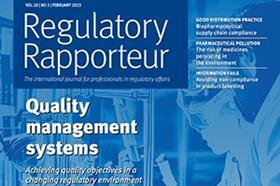It is a simple fact that the establishment of a robust quality management system (QMS) can both drive – as well as facilitate – regulatory compliance across all layers of business and operations in the pharma and MedTech industries. However, there is no doubt that the mention of QMS can still strike fear into even the most seasoned of regulatory professionals.
While there is much to say about quality systems, in this issue we will focus on two very specific aspects.

Regulatory Rapporteur
February 2023 | Volume 20 | No.2
First, Taylor and Miller have considered the aspects of QMS that are pivotal to compliance within the MedTech industry. The EU has established the Medical Device Regulation (MDR) and In Vitro Diagnostic Regulation (IVDR) as replacements to the Medical Devices Directive (MDD) and ln Vitro Diagnostic Devices Directive (IVDD) which had been in place for almost 25 years. In this article, the authors discuss how to successfully transition a QMS from MDD/IVDD to MDR/IVDR – based on a firm foundation in ISO 13485.
Myles offers us an interesting view on the value of incorporating good distribution practice (GDP) aspects into a company’s QMS. The author highlights that failure of the QMS to incorporate GDP aspects – both pre- and post-market – may have regulatory implications throughout the product lifecycle. This can include, but is not limited to, vendor management, materials management, and the manufacturer’s ability to appropriate scale-up and scale-out.
There is no doubt that the mention of QMS can still strike fear into even the most seasoned of regulatory professionals
Moving away from our focus topic, Littlebury provides the results of some thought-provoking research regarding trends and challenges for companies in maintaining product information in line with important reference safety information. The author’s research identifies some common issues the pharmaceutical industry may experience when updating product information and presents a valuable schedule of recommendations to increase compliance with legal obligations.
Environmental issues are rapidly moving front-and-centre as a global priority for all kinds of organisations and no less so within our industry. Here, McGuinness and Kuiken present the first in a two-part series on the environmental impact of pharmaceuticals. In this article, the authors consider the scope of subject areas in relation to the environmental impact of pharmaceuticals and anticipate future action in the context of how this might impact upon regulatory affairs.
A major challenge in the design of effective regulation is to implement a framework that facilitates compliance without stifling innovation. And, at the same time, allow firms to achieve this in a cost-effective way – such that smaller industry players can continue to operate and flourish. However, as highlighted by Bassett, there are concerns that this has not always been the case, as has been demonstrated in recent criticism of the new MDR/IVDR framework, where the fallout of regulatory demands is still to be fully felt.
In the first in a series of webinar ‘round-up’ pieces, Van Garsse et al provide a summary of a session entitled: ‘Navigating Post Market Surveillance/Performance and clinical follow-up requirements for IVDs and medical devices’, based on an online seminar presentation made by Quality by Design (QbD group) in collaboration with TOPRA. In a nod to our focus topic, Van Garsse et al concludes that the post-market surveillance for a medical device is comparable to an internal audit for a QMS, in that it ensures continued compliance of a device in assuring that the quality, safety and performance achieved in a real use environment meets the requirements set by the manufacturer.
Our final piece, a webinar review of an online seminar presentation, was made in collaboration with TOPRA and hVIVO. In ’Accelerated regulatory pathways: Vaccines for tropical diseases’ , Bruno Speder explores how human challenge trials can support the development of treatments and vaccines for tropical diseases and accelerate their regulatory approval.


































